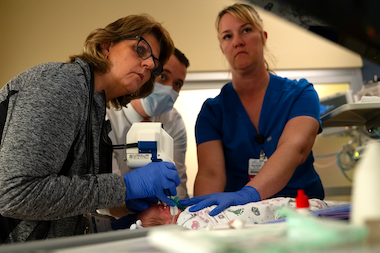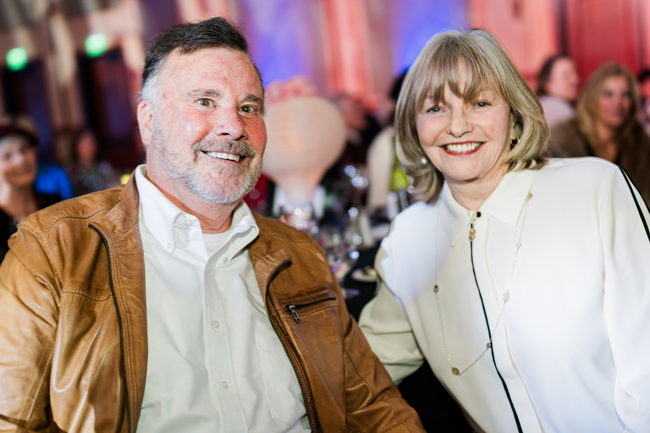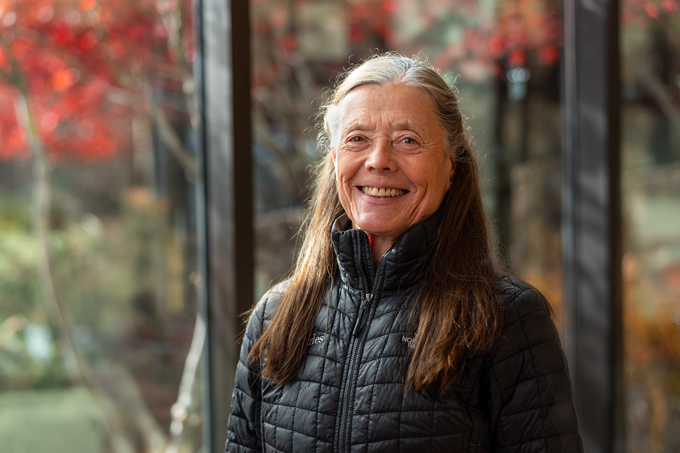Pictured above: From left, Bette Johnson, neonatal nurse practitioner, examines an infant’s retina with help from pediatric ophthalmologist John Davis and NICU nurse Rochelle Simonds.
St. Charles’ Neonatal Intensive Care Unit has a new tool to help prevent blindness in premature infants, thanks to $85,000 in funding from St. Charles Foundation. The new retinal camera now in use allows caregivers to take high quality images of babies’ eyes, giving ophthalmologists the ability to detect early warning signs and recommend treatment for infants before the disease progresses, possibly leading to blindness.
“We feel very fortunate to have this new tool, and the improved monitoring and quality of care for our patients. It is exciting for St. Charles to have the newest technology and the best equipment to support our community,” said Dr. Patrick Lewallen, NICU medical director. “We are grateful to the Foundation for helping raise the level of care our infants are receiving that is ultimately reducing the risks that premature babies have visual difficulties related to prematurity.”
Infants who are born premature are vulnerable to a number of health concerns – including eye disease and blindness. This is caused by a condition called retinopathy of prematurity. Infants born before 30 weeks’ gestation or weighing less than 3 pounds need to be scheduled for regular eye exams following birth. Until 2024, those exams at the St. Charles NICU were not that dissimilar from a regular eye exam: a pediatric ophthalmologist would shine a light into the eye and provide a written description of what was observed.
But starting this year, caregivers in the NICU are using a state-of-the-art retinal camera to observe and record the condition of the eye, thanks to donors who gave to the St. Charles Foundation’s General Fund. The camera takes highly detailed photos of the retina so they can be closely examined and compared to images over time. Early detection is key for this condition, as it is very treatable.
Pediatric Ophthalmologist Dr. John Davis works at the Oregon Health & Science University Casey Eye Institute’s Bend clinic and visits the NICU at St. Charles at least once a week to evaluate premature babies meeting criteria for this special monitoring. OHSU’s Bend clinic utilizes a similar retinal camera to the one used in the NICU. This allows for easy collaboration between the two organizations to compare images and best support patients as they transition from NICU to an outpatient setting.
When infants are born, blood vessels in their eyes have not fully developed, explained Davis. It takes between 36-40 weeks for infants to completely develop these blood vessels, and in premature infants, sometimes they never fully develop, which can lead to visual impairment and blindness.
Catching it early is critical as there are ways of treating it through the injection of a medication or laser procedure.
“The majority of patients who are screened do not need treatment, but for those that do, this is a critical tool to preserve vision,” said Davis.
The retinal camera is an example of new technology that is funded through St. Charles Foundation to give caregivers access to the best tools possible to treat patients.
“This is an example of how the Foundation can elevate our care for patients from good to excellent,” said Jenny O’Bryan, Executive Director for the Foundation, about why this project was funded. “Our goal is to raise funds that ultimately elevate the care we are able to provide for people in Central Oregon.”





